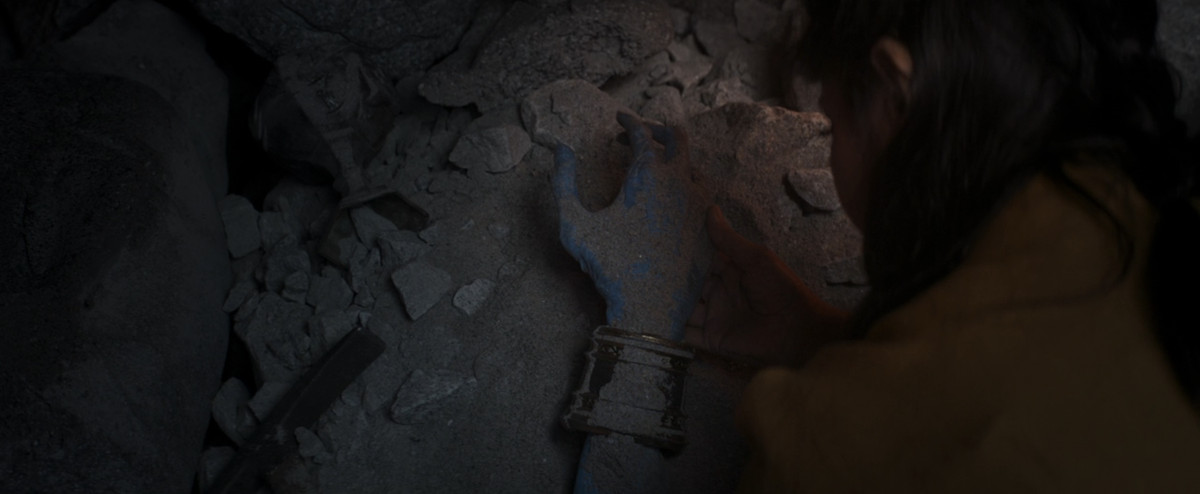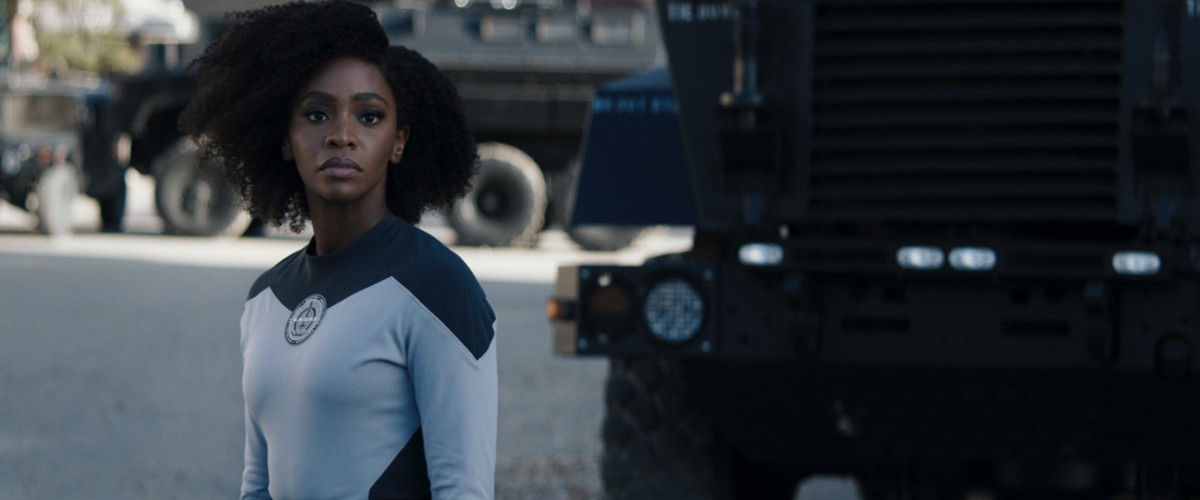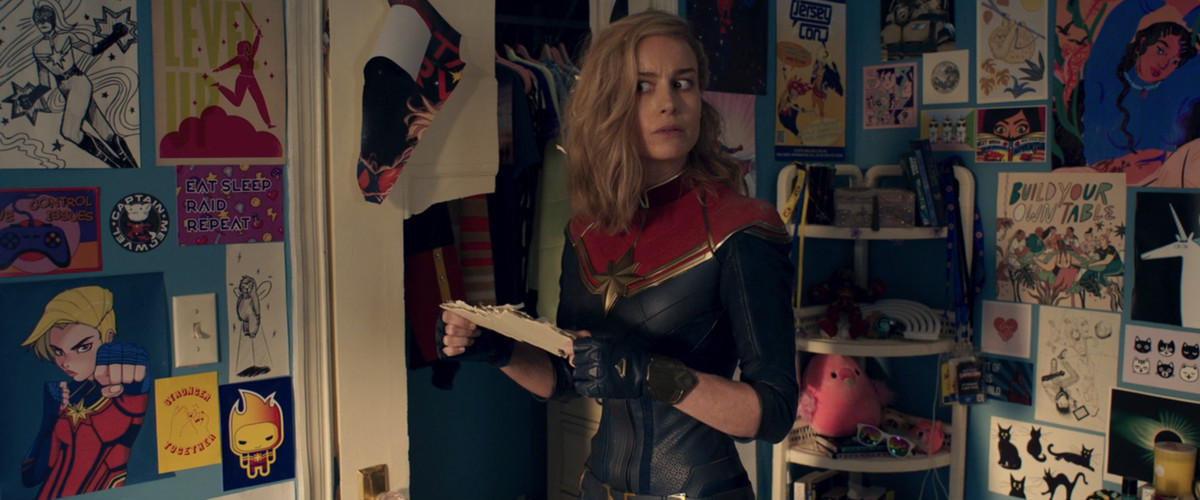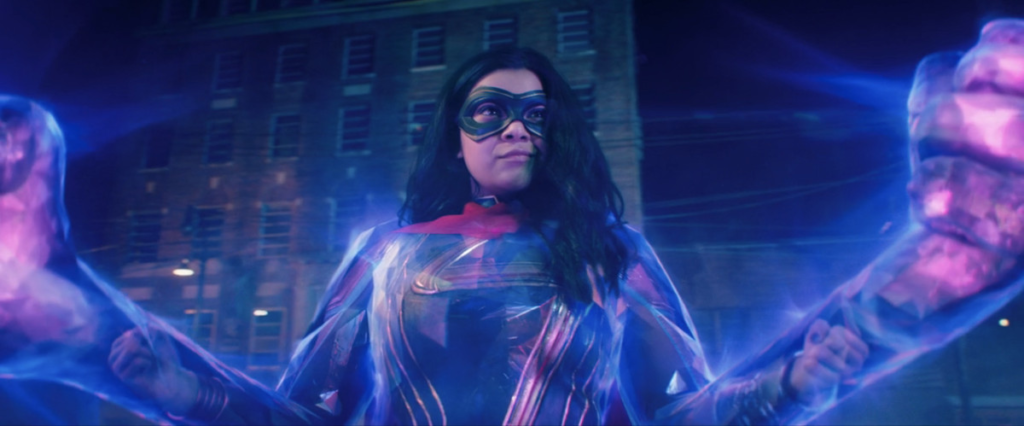With the release of The Marvels, Carol Danvers (Brie Larson) returns to the big screen in earnest for the first time since 2019’s Avengers: Endgame. And she’ll be joined by some familiar faces.
The Marvels is the sequel to 2019’s Captain Marvel and the first true crossover film in Phase 5, combining the characters and plotlines of a dizzying number of MCU titles that date back to the Infinity Saga: Captain Marvel, Endgame, WandaVision, Ms. Marvel, and Secret Invasion. Along with the returns of Danvers and Nick Fury (Samuel L. Jackson), the project also stars teenage superhero Kamala Khan (Iman Vellani) from Ms. Marvel and Monica Rambeau (Teyonah Parris) from WandaVision, the latter of whom has grown up and gotten powers of her own since she was introduced as a child in the 1990s-set Captain Marvel. Together, Kamala, Monica, and Carol form a new superteam to face a threat that the all-powerful Captain Marvel apparently can’t handle alone: a Kree revolutionary known as Dar-Benn (Zawe Ashton).
The Marvels aims to go higher, further, and faster than its predecessor did in 2019. More heroes, new planets—there’ll even be more Flerken to delight and terrify as the stakes in the ongoing Kree-Skrull conflict are raised higher than ever. And clocking in with a running time of just 105 minutes, the film sets a record pace for the fastest finish in MCU history. Whether The Marvels can ascend to the same box office heights as Captain Marvel is another matter, though, and the odds are certainly stacked against it.
Captain Marvel raked in $1.1 billion globally, and no small part of that success came from the film’s connection to Endgame, the culminating crossover event of the Infinity Saga. Captain Marvel was an origin story that helped set up Endgame, scheduled for release just a month after Captain Marvel opened, at the peak of Marvel Studios’ reign. But times have changed for the studio, and the upcoming sequel is being released under much different circumstances. The Marvels is itself a culminating crossover released during a period of decline for Marvel Studios, with the film building off Marvel’s two least-viewed live-action TV shows to date, Secret Invasion and Ms. Marvel. Factor in the restrictions of the ongoing SAG-AFTRA strike, which limits the film’s promotional opportunities, and that finds The Marvels currently tracking for a $60 million three-day opening at the box office, which would be among the worst three-day starts that the studio has ever seen.
Directed by Nia DaCosta (Candyman), The Marvels arrives in theaters later this week to serve as the last MCU project in what has been a rough year for Marvel Studios. As the 33rd film in the history of the MCU, The Marvels may be proof of the challenges of navigating such an extensive tapestry of stories, character, and plot points, especially when projects around them aren’t registering with audiences like they used to. But it’s still a landmark moment for Marvel Studios that transports two new superheroes from TV to the big screen to join one of the last Avengers standing. It’s the first MCU film to be headlined by an ensemble of actresses, and DaCosta becomes the first Black female filmmaker to direct an MCU feature, as well as the youngest director to helm an MCU release at the age of 33.
There’s a lot of backstory to rehash in preparation for this film, and I can’t say that I would recommend a rewatch or first-time viewing for some of these projects in particular. (Looking at you, Secret Invasion.) But that’s what we have these primers for. Here’s everything you need to know about the three leading heroes set to join forces in The Marvels, and all the baggage they’re carrying with them.
Kamala Khan
Screenshots via Disney+
Let’s begin with the youngest member of our new supergroup, Kamala Khan.
At the start of 2022’s Ms. Marvel, Kamala is an average high schooler growing up in Jersey City. Given that this is the MCU, Kamala happens to be something of an Avengers superfan, with Captain Marvel being her favorite superhero. But when she finds a mysterious bangle passed down for several generations in her family, Kamala’s latent powers are unlocked and she becomes a superhero in her own right.
Across the limited series’ six episodes, the 16-year-old Kamala learns how to control her new abilities, which allow her to produce and manipulate fluorescent energy that she refers to as “hard light.” As she investigates the origins of the bangle, Kamala discovers that it once belonged to her great-grandmother Aisha (Mehwish Hayat), who arrived on Earth after being exiled from an alternate dimension—known as the Noor Dimension—along with four others. In 1942, Aisha found this mystical artifact in a Ten Rings temple located in India while it was still attached to the arm of a blue-skinned corpse. She and her group of exiled Clandestines believed that when it was used along with a similar bangle, they would all be able to return home. But Aisha gets separated from the rest of her crew and starts a new life, building a family that she eventually chooses to protect in favor of letting the rest of the Clandestines return to the Noor Dimension.

By the end of Ms. Marvel, Kamala has established herself as a beloved protector in her community, and she’s also revealed to be the MCU’s first mutant. But questions remain about the true origins of Kamala’s bangle. Given that it was found on some stray blue arm, The Marvels seems primed to provide some answers in the form of a connection to the Kree, a militaristic alien race who are predominantly blue-skinned. Whether the history of the bangle is revealed in full, it’s clear that this artifact is the key piece that ties Kamala and Captain Marvel together. In a mid-credits scene in the series finale, Kamala is in her bedroom when the bangle begins to light up, and she is suddenly sent flying into her closet, only for Carol Danvers to reemerge in her place.
Since that stinger first teased The Marvels in the summer of 2022, more details and clips from the movie have shed some light on this bizarre body-swapping moment. Along with a familiar hammer used by Kree warriors known as Accusers, Dar-Benn wields a bangle that looks very similar to the one that Kamala owns. And Dar-Benn appears to have done something to mess with Carol’s, Monica’s, and Kamala’s abilities that’s causing the trio to be transported across the galaxy instantaneously. “She’s entangled our light-based powers,” Monica Rambeau says in a trailer for the film. “So we switch places whenever we use them.”
Ms. Marvel returns in The Marvels as a relative novice to this whole superhero business, especially compared to the likes of Captain Marvel, and she hasn’t even finished high school yet. Luckily for Kamala, she’ll be joined for the journey to come by her parents, Muneeba (Zenobia Shroff) and Yusuf (Mohan Kapur), who—along with Kamala’s brother, Aamir (Saagar Shaikh)—represent a stabilizing force in her life that was crucial to her growth in Ms. Marvel.
Monica Rambeau

Next up we have Monica, whose origins are a bit more scattered across the history of the MCU.
In Captain Marvel, Monica is introduced as a child, portrayed by Akira Akbar, whom Carol affectionately calls “Lieutenant Trouble.” Her mother, Maria (Lashana Lynch), is Danvers’s best friend, a U.S. Air Force pilot with the call sign “Photon,” and she joins Carol in a secretive government program as test pilots. Although Rambeau and Danvers didn’t know it at the time, Project P.E.G.A.S.U.S. is run by a rogue Kree scientist who is attempting to use the Tesseract to build a light-speed engine that can help the shape-shifting Skrulls evade the clutches of the Kree Empire once and for all. When the engine gets destroyed by the Kree, Danvers inadvertently gains her superpowers from the Tesseract and forgets her life before her transformation as she’s taken back to the Kree homeworld, Hala. Later, Danvers and Nick Fury eventually team up with the Skrull general Talos (Ben Mendelsohn) to save his people, and Maria joins them in space. Through it all, the young Monica is inspired to grow up and become a space-traveling hero like her Auntie Carol.
After the events of Captain Marvel, Danvers travels to distant planets as she searches for a new homeworld for the Skrulls to inhabit, leaving Maria and Monica behind in the process. While Fury takes on greater responsibilities at S.H.I.E.L.D., Maria becomes the founder of an intelligence agency called Sentient Weapon Observation and Response Division (S.W.O.R.D.), which works to protect Earth from extraterrestrial and extra-dimensional threats. (Yes, there is S.W.O.R.D. and S.H.I.E.L.D., and we’re not even done with these acronyms yet.)
When we see Monica again in WandaVision, she’s reintroduced as an adult, played by Parris, who’s been working as an agent of S.W.O.R.D. The 2021 limited series introduces this mysterious intelligence agency and weaves in all of these developments about the Rambeaus in the decades that followed the events of Captain Marvel as Monica becomes a key supporting character in a narrative that ultimately belongs to Wanda Maximoff (Elizabeth Olsen). But WandaVision also provides something of an origin story for Monica as she gains her energy-based powers.
During a flashback in WandaVision, we learn that Monica was one of the many victims of the infamous snap, losing precious years of her life—during which she missed the death of her mother—thanks to some evil purple alien with some wild ideas on population control. As a result of this prolonged leave of absence from work (and, you know, from life), Monica’s new boss at S.W.O.R.D. grounds her from any off-world missions and sets her up with what he believes to be an easier case to get her back on her feet. Of course, that case ends up involving a grieving former Avenger who is so powerful that she manages to hold an entire New Jersey town hostage and alter its reality to help her cope with the loss of her partner.
Monica plays a major role in rescuing the residents of Westview from Wanda’s “Hex” and all of the chaos that ensued inside it. After passing through the magical barrier that Wanda created around her town multiple times, Monica’s DNA gets altered, causing her to develop superhuman abilities. The extent of what she’s capable of is only briefly seen in WandaVision, given that her transformation arrives late in the series, but one scene in the finale displays her potential. Monica jumps in front of a hail of bullets, and she appears to absorb their kinetic energy as they phase through her, robbing them of their velocity upon impact and rendering them useless.
After Monica helps save Westview, a mid-credits scene in the finale teases a new gig for her that would finally send her to space. A Skrull, posing as an FBI agent, extends Rambeau an invitation for her to join Fury at S.A.B.E.R., an aerospace defense system run by Fury and a group of Skrulls who have yet to find a homeworld to relocate to. These plot strands all set up where we’ll find Monica in The Marvels, reunited with the ones who opened up her world to the cosmos as a child.
In a bit of a throwaway exchange in the fifth episode of WandaVision, the series also hints at an awkward tension between Monica and Carol. When Jimmy Woo (Randall Park) and Darcy Lewis (Kat Dennings) are talking about Captain Marvel, Monica quickly redirects the conversation away from her estranged aunt, deflecting with enough purpose that Jimmy and Darcy both take notice. The Marvels will soon bring Rambeau and Danvers back together again, and given that Monica likely feels as if Carol deserted her and her mother, the pair will have a lot to catch up on.
Carol Danvers, the Skrulls, and the Kree

That leads us back to the superhero who was there at the start of it all: Captain Marvel.
We’ve already covered Captain Marvel’s origins along the way, but there have been other developments involving Fury’s First Avenger and the Kree-Skrull war since her origin film. Carol Danvers returned in Endgame to contend for the Strongest Avenger title, proving invaluable in the final battle against Thanos (Josh Brolin). Compared to the rest of the Avengers, her presence in the film is much more limited, which speaks to the responsibility that she has to other planets beyond Earth.
Through the villainous Dar-Benn, the Kree will become a central focus in the MCU for the first time since Captain Marvel, when Danvers thwarted their attempts to eliminate the Skrulls. At the end of the film, the fledgling superhero sent a message to the Kree leader, an artificial intelligence known as the Supreme Intelligence, warning it that she would soon return to Hala to end the war. What happened on Hala remains a mystery, but what’s clear is that this Kree-Skrull conflict is far from over. And we know that thanks to Secret Invasion.
Now, Secret Invasion is a low point for Marvel Studios creatively, commercially, and critically, but it is, unfortunately, another setup for The Marvels. The 2023 limited series picked up the narrative threads of Captain Marvel to show how the Skrulls had grown weary of Danvers’s and Fury’s inability to find them a new homeworld. While some of the shape-shifters remained loyal to Fury, including Talos, others saw an opportunity to turn Earth into the new permanent home for Skrulls that couldn’t be found elsewhere. Gravik (Kingsley Ben-Adir) leads a resistance movement, with Skrulls infiltrating positions of power worldwide in a plan designed to render the planet uninhabitable for humans. Fury ultimately stops it with the help of Talos’s daughter G’iah (Emilia Clarke), though he lets several allies, including Talos, die in the process. (G’iah has also become an unstoppable force who could destroy the Kree Empire alone, but that’s an issue for another day.)
At the end of Secret Invasion, the U.S. president (Dermot Mulroney) declares an all-out war against the Skrulls, while Fury leaves the planet to return to S.A.B.E.R. with his wife, Priscilla (Charlayne Woodard), who’s really a Skrull named Varra. (There’s even a little make-out scene with Fury and his green-skinned alien partner. It’s a lot.) On the way out of this disaster of a situation that he’s created on Earth, Fury informs Varra that the Kree are “open to peace talks with the Skrulls.” This peace summit will likely be one of the main connecting points between Secret Invasion and The Marvels, but it’s clear enough that Dar-Benn, at least, has a more sinister agenda in mind.
As evidenced by the length of this piece, there are a lot of moving parts heading into The Marvels. With its 105-minute running time, there is simply no way that this film will be able to address them all. But even with the shortened narrative space, it will be an opportunity to develop the stories of Kamala Khan and Monica Rambeau, in particular, as The Marvels becomes another test case for the studio’s ability to transfer its characters and stories from streaming series to feature-length films. WandaVision and Ms. Marvel are two of the better shows in Marvel’s growing TV catalog, which should provide a strong foundation for the film to build on, even if viewership numbers for the latter series were low.
Marvel Studios is at a crucial juncture right now as the fans’ interest continues to waver at almost every turn. (For as good as Loki’s second season has been, even Marvel’s flagship series has seen a dramatic decline in viewership since its first six-episode run.) There is perhaps an undue amount of pressure on the Captain Marvel sequel given the recent flops and bad publicity coming out of the studio lately, and based on the box office predictions, it seems doomed to be another failure by Marvel standards. With all the recent rumors circulating about a potential reset coming to the MCU, how The Marvels performs may tell us more about where Marvel is heading next, one way or another.

